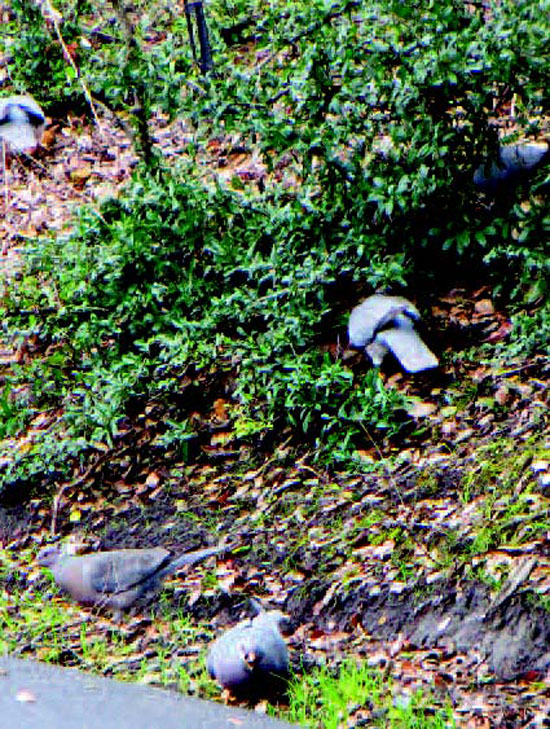 | | | Band-tailed pigeons eating acorns. Photo Krysta Rogers | | | | | | Like a scene from a Hitchcock movie, birds are dying in Lamorinda. At least one flock of approximately 30 band-tailed pigeons in Orinda has already been devastated, says Dr. Guthrum Purdin of Lindsay Wildlife Museum in Walnut Creek. "These birds look sick," he said. "It's upsetting for people to see."
 The California native bird with an already low reproduction rate - single births happen only two or three times a year - is experiencing an outbreak of Trichomonosis, a disease caused by a single-celled microscopic protozoan parasite, Trichomonas gallinae.
The California native bird with an already low reproduction rate - single births happen only two or three times a year - is experiencing an outbreak of Trichomonosis, a disease caused by a single-celled microscopic protozoan parasite, Trichomonas gallinae.
 "It was driving me crazy," said Orinda resident Leeann Brady, who wondered if the deaths of the pigeons were caused by poisoning.
"It was driving me crazy," said Orinda resident Leeann Brady, who wondered if the deaths of the pigeons were caused by poisoning.
 "It's definitely in the Orinda and Lafayette area," agreed Krysta Rogers of the California Department of Fish and Wildlife. Rogers is an environmental scientist and avian specialist who visited the affected area Jan. 16. She says the band-tailed pigeons are typically found in higher elevations in oak woods and conifer forests. They feed on acorns, eating them whole. The disease causes lesions near the mouth restricting their ability to feed and they die of starvation or suffocation.
"It's definitely in the Orinda and Lafayette area," agreed Krysta Rogers of the California Department of Fish and Wildlife. Rogers is an environmental scientist and avian specialist who visited the affected area Jan. 16. She says the band-tailed pigeons are typically found in higher elevations in oak woods and conifer forests. They feed on acorns, eating them whole. The disease causes lesions near the mouth restricting their ability to feed and they die of starvation or suffocation.
 The disease spreads readily when birds flock during winter months and generally dissipates as the pigeons pair off during mating season. Rogers said the disease Trichomonas gallinae is strictly an avian parasite and will not spread to humans or mammals. Other birds including mourning doves, crow, raptors and rock pigeons may contract the disease from close contact with infected birds.
The disease spreads readily when birds flock during winter months and generally dissipates as the pigeons pair off during mating season. Rogers said the disease Trichomonas gallinae is strictly an avian parasite and will not spread to humans or mammals. Other birds including mourning doves, crow, raptors and rock pigeons may contract the disease from close contact with infected birds.
 "Trichomonosis," Purdin explains, "is a very, very old disease" dating back to the time of Tyrannosaurus Rex. It is generally an environmentally weak disease that survives only in warm and wet environments. But birds seek feeders and bird baths during drought conditions, and that makes it worse. Purdin is also concerned that a new strain of Trichomonosis, caused by Trichomonas stableri may be more virulent. Where gallinae generally attacks pigeons already weakened by other health issues, stableri takes hold even within the healthy bird population.
"Trichomonosis," Purdin explains, "is a very, very old disease" dating back to the time of Tyrannosaurus Rex. It is generally an environmentally weak disease that survives only in warm and wet environments. But birds seek feeders and bird baths during drought conditions, and that makes it worse. Purdin is also concerned that a new strain of Trichomonosis, caused by Trichomonas stableri may be more virulent. Where gallinae generally attacks pigeons already weakened by other health issues, stableri takes hold even within the healthy bird population.
 "We're getting lots of animals coming in," Purdin says. Normally they get 36 all year but this month they've already had 31. The museum would be overwhelmed if not for the disease's high mortality rate. Pigeons either die en route to the museum or before they've been examined. The remaining few have been euthanized.
"We're getting lots of animals coming in," Purdin says. Normally they get 36 all year but this month they've already had 31. The museum would be overwhelmed if not for the disease's high mortality rate. Pigeons either die en route to the museum or before they've been examined. The remaining few have been euthanized.
 "Identifying the species and strain of parasites is one of the primary goals of our research," Rogers says. She encourages the public to report pigeon deaths by calling (916) 358-2790, to take sick birds to the Lindsay Wildlife Museum, and to remove bird feeders and birdbaths from their yards.
"Identifying the species and strain of parasites is one of the primary goals of our research," Rogers says. She encourages the public to report pigeon deaths by calling (916) 358-2790, to take sick birds to the Lindsay Wildlife Museum, and to remove bird feeders and birdbaths from their yards.
 If you must keep feeders, Rogers says to wash them weekly, scrubbing first with soap and water, then soaking 5 to 10 minutes in a weakened (1:10) bleach/water solution. Drain and clean bird baths similarly and rinse thoroughly.
If you must keep feeders, Rogers says to wash them weekly, scrubbing first with soap and water, then soaking 5 to 10 minutes in a weakened (1:10) bleach/water solution. Drain and clean bird baths similarly and rinse thoroughly.
 To report pigeon deaths online, go to https://www.wildlife.ca.gov/Conservation/Laboratories/Wildlife-Investigations/Monitoring/Mortality-Report.
To report pigeon deaths online, go to https://www.wildlife.ca.gov/Conservation/Laboratories/Wildlife-Investigations/Monitoring/Mortality-Report.

|
